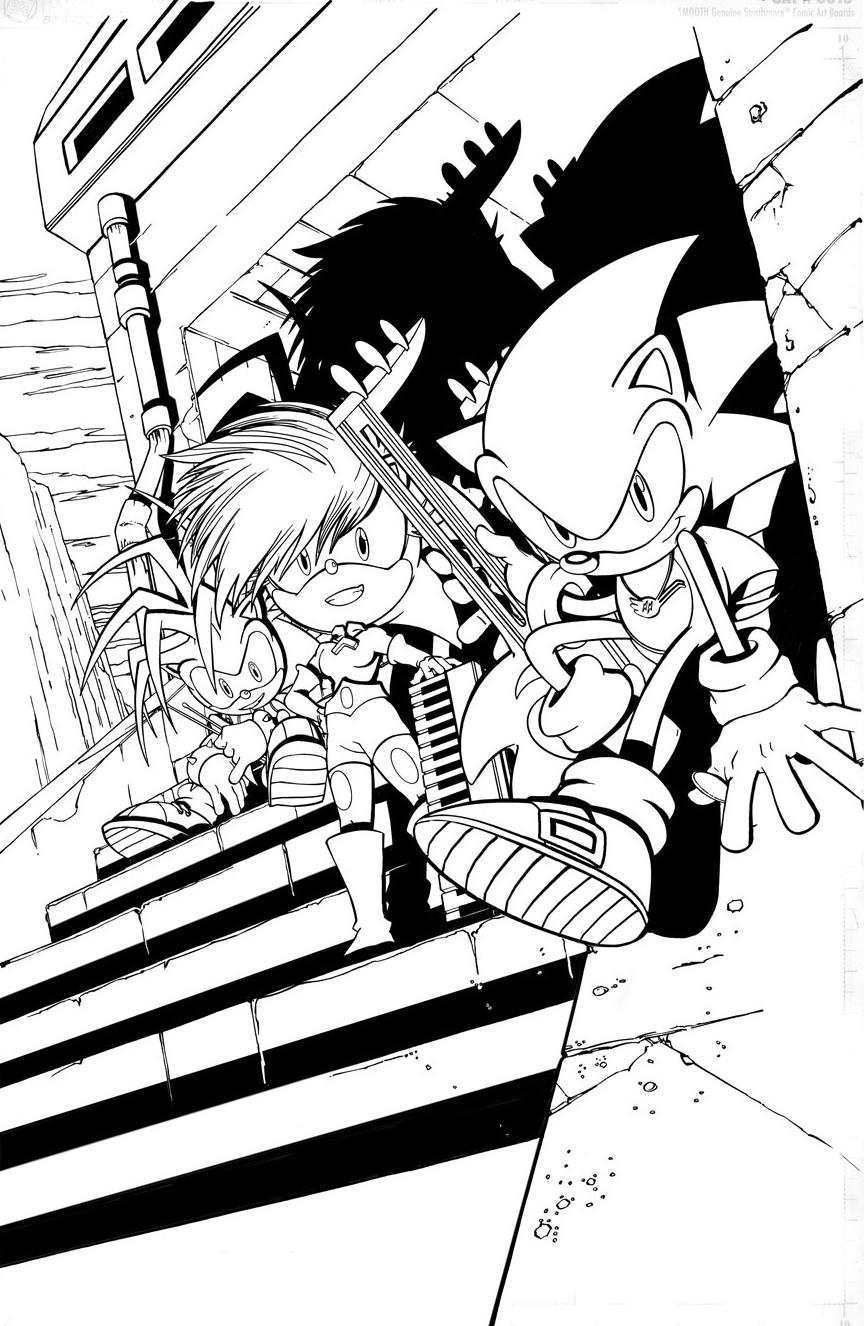Archie Comics' "Sonic Underground" epilogue (partially lost production material from cancelled comic based on animated TV show; 2012-2013)
Sonic Underground was an animated TV show based on Sega's popular video game franchise Sonic the Hedgehog airing for one season from January 6th to to May 23rd, 1999. Nearly 14 years later, at New York Comic Con 2012, Archie Comics announced that issue #50 of their Sonic Universe comic series would be an epilogue to Sonic Underground. Still, when the issue came out in early 2013, it had been replaced by a story about Metal Sonic, with the epilogue becoming canceled.
Background
Sonic Underground follows Sonic and his siblings, Sonia and Manic, as they try to reunite with their mother, the former queen of Mobius, Aleena. Each sibling has a magical medallion based on a different musical instrument; Sonic's medallion is a guitar, Sonia's is a keyboard, and Manic's is a drum set. Doubling as traditional instruments and weapons, they use their medallions to form the underground rock band, "Sonic Underground" to fight off the evil Dr. Robotnik and his army of Swat-Bots. The latter now rule Mobius with an iron fit. The series was prematurely canceled, leading the show's main plot thread of finding the siblings' mother unresolved. The first rumblings of a comic-based epilogue to the show came about in mid-2009 when a poll was posted to Ian Flynn's BumbleKing forum asking users if they wanted him to write an epilogue for Underground as part of the Sonic Universe comic series. A spin-off of Archie's long-running Sonic the Hedgehog comic series focused on expanding its universe. As the head writer of Sonic comics since 2006, Flynn seemed to respond to the idea with cautious enthusiasm replying to the post with, "I dunno - it's an intriguing enough idea, but I'd kind of feel like I was stepping on the original creatives, As it stands, even if we did get the green light for such a project, it wouldn't see the light of day until 2011 at earliest." [1]
Announcement and Cancelation
Three years later, at New York Comic Con 2012, an epilogue was announced for Underground that would serve as Sonic Universe's 50th issue with the current Executive Director of Editorial Paul Kaminski saying, "We said, you know what? We need to do an epilogue to Sonic Underground -- The last song, the last concert. What better way to celebrate fifty issues of Sonic Universe than hiring Sonic's band to play?"[2] but when the issue hit store shelves in March 2013, the epilogue was nowhere to be found instead of being replaced by a story about Metal Sonic. When Flynn appeared on the Sonic Lost World First Play Marathon that October, he stated that Sonic Underground is off-limits, he went on to clarify that "That's been in place since before I got on the book. The finale in Sonic Universe was supposed to be a special one-time thing. We're still trying to find a way to get it to happen."[3] This mandate was likely put in place sometime after Sonic Super Special issue #10 as it features a story what Archie's main Sonic crosses over into the Underground universe. In late 2014 Flynn stated that Lost Hedgehog Tales, a document detailing scrapped concepts from his time as head writer, would include the epilogue's story.[4] Excluding five released pages, which contain no mention of the epilogue, the document remains unreleased, with Flynn stating on Twitter in August 2021, "I've promised the fandom to tell all in Lost Hedgehog Tales when it's safe to do so, which isn't yet. But one day. Just not today. Or tomorrow. Or...for a while."[5]
Known Production Materials
While on the Sonic Lost World First Play Marathon, Flynn mentioned he never penned a formal script, but he had "lots and lots of notes". The only other known piece of production material is a sample cover drawn by Patrick "Spaz" Spaziante, which was released alongside the book's announcement.[3]
See also
- Archie Comics' Sonic The Hedgehog "Endangered Species" (lost original storyline of comic book series based on "Sonic The Hedgehog" game series; 2013)
- Archie Comics' Sonic Universe "Chaotix Quest: Parts 1-2"
- Adventures of Sonic the Hedgehog (partially lost unaired pilot of DIC animated series; 1992)
- Sonic The Hedgehog SatAM (partially lost unused TV intro for animated series; 1993)
References
- ↑ https://web.archive.org/web/20151102122354/http://bumbleking.com/forum/viewtopic.php?p=60017#60017
- ↑ https://www.cbr.com/nycc-archie-crosses-over-sonic-and-mega-man/
- ↑ 3.0 3.1 https://web.archive.org/web/20200531211222/http://www.tssznews.com/2013/10/29/is-the-archie-sonic-underground-epilogue-dead/
- ↑ https://web.archive.org/web/20160404021312/https://twitter.com/IanFlynnBKC/status/510281489292877824
- ↑ https://mobile.twitter.com/ianflynnbkc/status/1427327281626746880
